HND in International Travel and Tourism: Sustainable Tourism Report
VerifiedAdded on 2022/12/28
|12
|3287
|50
Report
AI Summary
This report delves into the realm of sustainable tourism, examining its evolution in response to the adverse effects of the tourism industry. It begins by defining sustainable tourism and then discusses key drivers such as resource scarcity, environmental impact, and pollution. The report analyzes the principles underpinning the development of sustainable tourism strategies, including sustainable resource use, waste reduction, support for local economies, staff training, and responsible marketing. The role of key stakeholders, including governments, tourists, host communities, tourism businesses (specifically TUI Group), and the media, is evaluated in the global sustainable tourism agenda. The report further explores the ways in which these stakeholders contribute to sustainable tourism. Finally, the report compares and contrasts the outcomes of sustainable tourism strategies in both emerging and established tourism destinations. The report aims to provide a comprehensive understanding of sustainable tourism development and its implications for the future of the industry.

Talent Management in Management
and Leadership
and Leadership
Paraphrase This Document
Need a fresh take? Get an instant paraphrase of this document with our AI Paraphraser
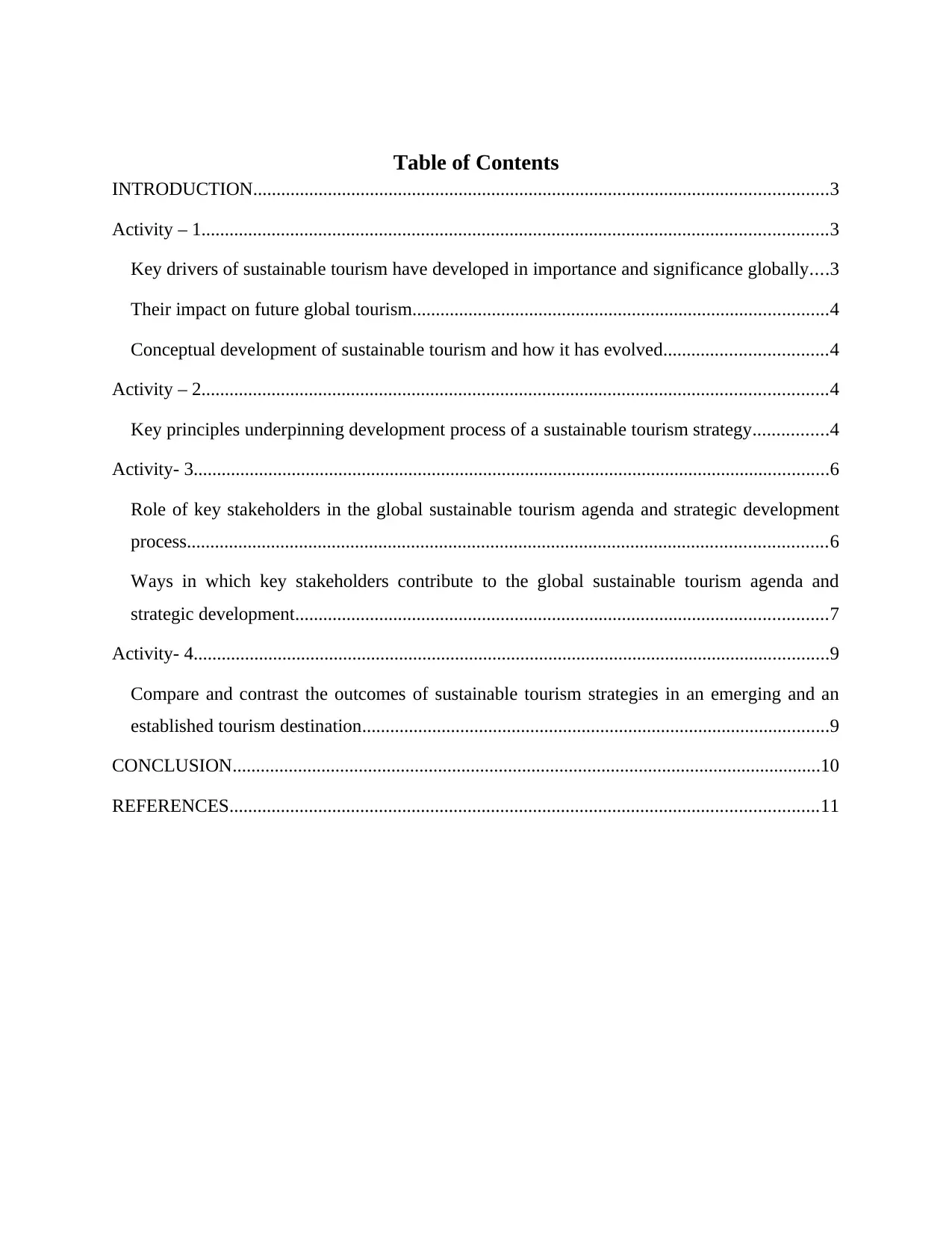
Table of Contents
INTRODUCTION...........................................................................................................................3
Activity – 1......................................................................................................................................3
Key drivers of sustainable tourism have developed in importance and significance globally....3
Their impact on future global tourism.........................................................................................4
Conceptual development of sustainable tourism and how it has evolved...................................4
Activity – 2......................................................................................................................................4
Key principles underpinning development process of a sustainable tourism strategy................4
Activity- 3........................................................................................................................................6
Role of key stakeholders in the global sustainable tourism agenda and strategic development
process.........................................................................................................................................6
Ways in which key stakeholders contribute to the global sustainable tourism agenda and
strategic development..................................................................................................................7
Activity- 4........................................................................................................................................9
Compare and contrast the outcomes of sustainable tourism strategies in an emerging and an
established tourism destination....................................................................................................9
CONCLUSION..............................................................................................................................10
REFERENCES..............................................................................................................................11
INTRODUCTION...........................................................................................................................3
Activity – 1......................................................................................................................................3
Key drivers of sustainable tourism have developed in importance and significance globally....3
Their impact on future global tourism.........................................................................................4
Conceptual development of sustainable tourism and how it has evolved...................................4
Activity – 2......................................................................................................................................4
Key principles underpinning development process of a sustainable tourism strategy................4
Activity- 3........................................................................................................................................6
Role of key stakeholders in the global sustainable tourism agenda and strategic development
process.........................................................................................................................................6
Ways in which key stakeholders contribute to the global sustainable tourism agenda and
strategic development..................................................................................................................7
Activity- 4........................................................................................................................................9
Compare and contrast the outcomes of sustainable tourism strategies in an emerging and an
established tourism destination....................................................................................................9
CONCLUSION..............................................................................................................................10
REFERENCES..............................................................................................................................11
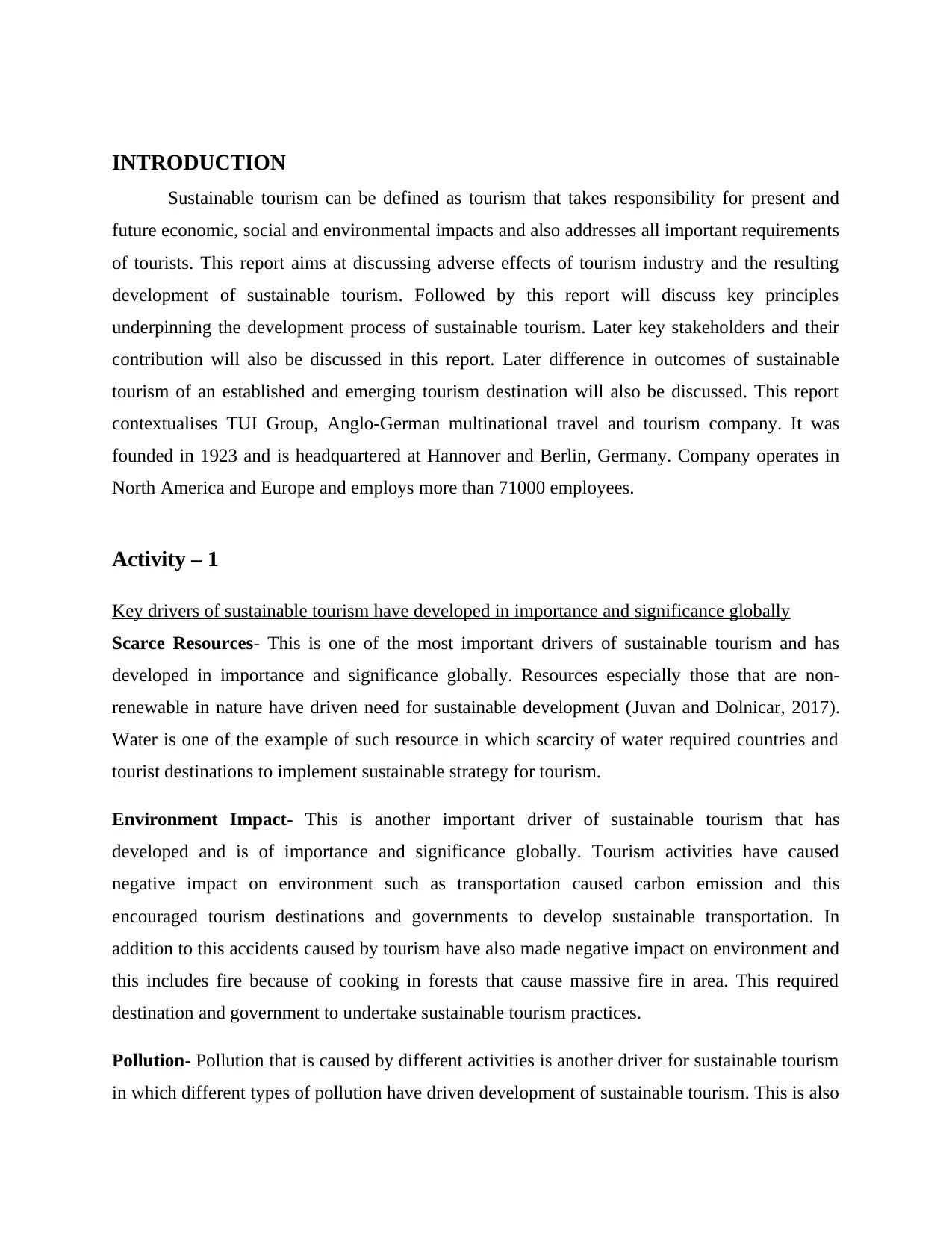
INTRODUCTION
Sustainable tourism can be defined as tourism that takes responsibility for present and
future economic, social and environmental impacts and also addresses all important requirements
of tourists. This report aims at discussing adverse effects of tourism industry and the resulting
development of sustainable tourism. Followed by this report will discuss key principles
underpinning the development process of sustainable tourism. Later key stakeholders and their
contribution will also be discussed in this report. Later difference in outcomes of sustainable
tourism of an established and emerging tourism destination will also be discussed. This report
contextualises TUI Group, Anglo-German multinational travel and tourism company. It was
founded in 1923 and is headquartered at Hannover and Berlin, Germany. Company operates in
North America and Europe and employs more than 71000 employees.
Activity – 1
Key drivers of sustainable tourism have developed in importance and significance globally
Scarce Resources- This is one of the most important drivers of sustainable tourism and has
developed in importance and significance globally. Resources especially those that are non-
renewable in nature have driven need for sustainable development (Juvan and Dolnicar, 2017).
Water is one of the example of such resource in which scarcity of water required countries and
tourist destinations to implement sustainable strategy for tourism.
Environment Impact- This is another important driver of sustainable tourism that has
developed and is of importance and significance globally. Tourism activities have caused
negative impact on environment such as transportation caused carbon emission and this
encouraged tourism destinations and governments to develop sustainable transportation. In
addition to this accidents caused by tourism have also made negative impact on environment and
this includes fire because of cooking in forests that cause massive fire in area. This required
destination and government to undertake sustainable tourism practices.
Pollution- Pollution that is caused by different activities is another driver for sustainable tourism
in which different types of pollution have driven development of sustainable tourism. This is also
Sustainable tourism can be defined as tourism that takes responsibility for present and
future economic, social and environmental impacts and also addresses all important requirements
of tourists. This report aims at discussing adverse effects of tourism industry and the resulting
development of sustainable tourism. Followed by this report will discuss key principles
underpinning the development process of sustainable tourism. Later key stakeholders and their
contribution will also be discussed in this report. Later difference in outcomes of sustainable
tourism of an established and emerging tourism destination will also be discussed. This report
contextualises TUI Group, Anglo-German multinational travel and tourism company. It was
founded in 1923 and is headquartered at Hannover and Berlin, Germany. Company operates in
North America and Europe and employs more than 71000 employees.
Activity – 1
Key drivers of sustainable tourism have developed in importance and significance globally
Scarce Resources- This is one of the most important drivers of sustainable tourism and has
developed in importance and significance globally. Resources especially those that are non-
renewable in nature have driven need for sustainable development (Juvan and Dolnicar, 2017).
Water is one of the example of such resource in which scarcity of water required countries and
tourist destinations to implement sustainable strategy for tourism.
Environment Impact- This is another important driver of sustainable tourism that has
developed and is of importance and significance globally. Tourism activities have caused
negative impact on environment such as transportation caused carbon emission and this
encouraged tourism destinations and governments to develop sustainable transportation. In
addition to this accidents caused by tourism have also made negative impact on environment and
this includes fire because of cooking in forests that cause massive fire in area. This required
destination and government to undertake sustainable tourism practices.
Pollution- Pollution that is caused by different activities is another driver for sustainable tourism
in which different types of pollution have driven development of sustainable tourism. This is also
⊘ This is a preview!⊘
Do you want full access?
Subscribe today to unlock all pages.

Trusted by 1+ million students worldwide
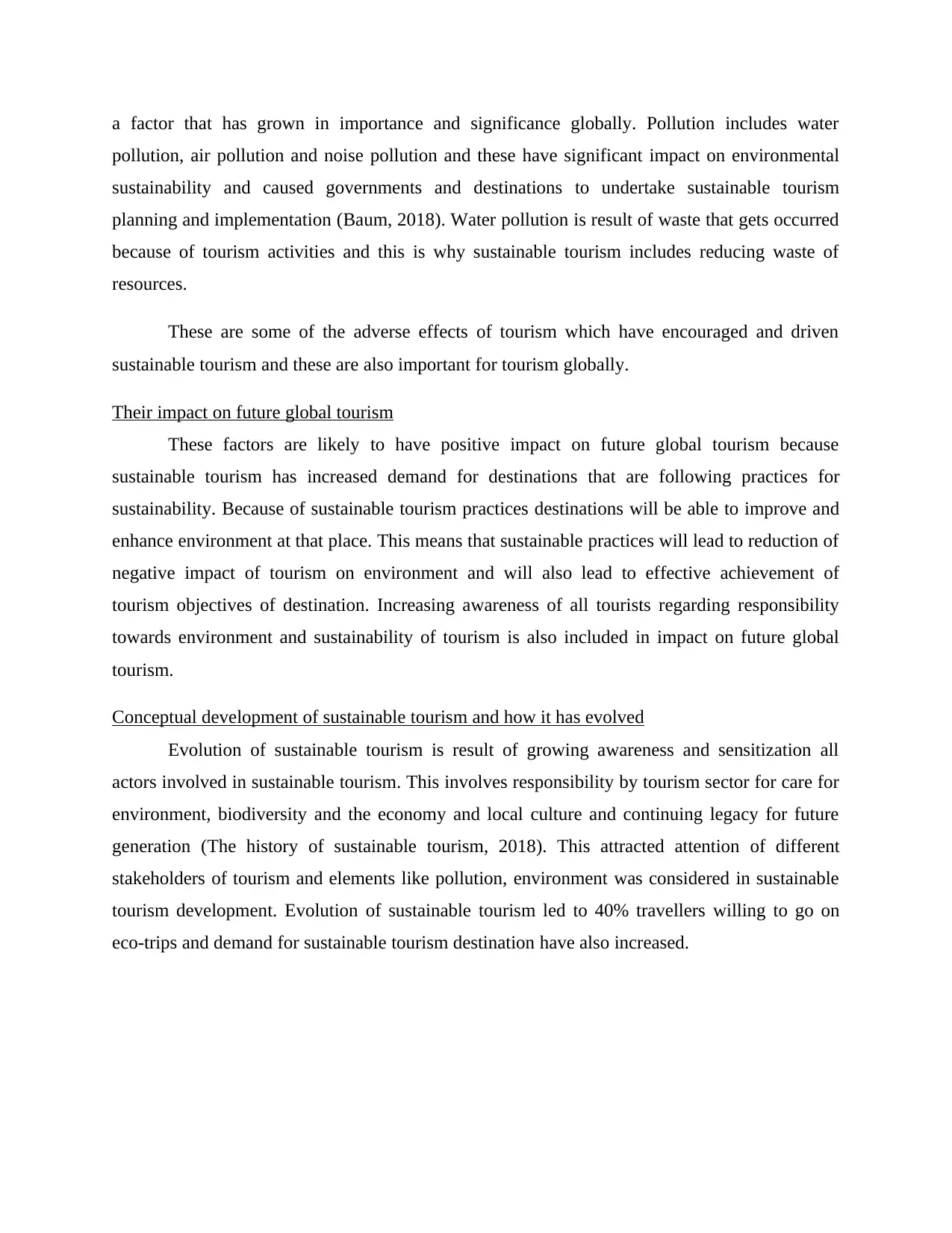
a factor that has grown in importance and significance globally. Pollution includes water
pollution, air pollution and noise pollution and these have significant impact on environmental
sustainability and caused governments and destinations to undertake sustainable tourism
planning and implementation (Baum, 2018). Water pollution is result of waste that gets occurred
because of tourism activities and this is why sustainable tourism includes reducing waste of
resources.
These are some of the adverse effects of tourism which have encouraged and driven
sustainable tourism and these are also important for tourism globally.
Their impact on future global tourism
These factors are likely to have positive impact on future global tourism because
sustainable tourism has increased demand for destinations that are following practices for
sustainability. Because of sustainable tourism practices destinations will be able to improve and
enhance environment at that place. This means that sustainable practices will lead to reduction of
negative impact of tourism on environment and will also lead to effective achievement of
tourism objectives of destination. Increasing awareness of all tourists regarding responsibility
towards environment and sustainability of tourism is also included in impact on future global
tourism.
Conceptual development of sustainable tourism and how it has evolved
Evolution of sustainable tourism is result of growing awareness and sensitization all
actors involved in sustainable tourism. This involves responsibility by tourism sector for care for
environment, biodiversity and the economy and local culture and continuing legacy for future
generation (The history of sustainable tourism, 2018). This attracted attention of different
stakeholders of tourism and elements like pollution, environment was considered in sustainable
tourism development. Evolution of sustainable tourism led to 40% travellers willing to go on
eco-trips and demand for sustainable tourism destination have also increased.
pollution, air pollution and noise pollution and these have significant impact on environmental
sustainability and caused governments and destinations to undertake sustainable tourism
planning and implementation (Baum, 2018). Water pollution is result of waste that gets occurred
because of tourism activities and this is why sustainable tourism includes reducing waste of
resources.
These are some of the adverse effects of tourism which have encouraged and driven
sustainable tourism and these are also important for tourism globally.
Their impact on future global tourism
These factors are likely to have positive impact on future global tourism because
sustainable tourism has increased demand for destinations that are following practices for
sustainability. Because of sustainable tourism practices destinations will be able to improve and
enhance environment at that place. This means that sustainable practices will lead to reduction of
negative impact of tourism on environment and will also lead to effective achievement of
tourism objectives of destination. Increasing awareness of all tourists regarding responsibility
towards environment and sustainability of tourism is also included in impact on future global
tourism.
Conceptual development of sustainable tourism and how it has evolved
Evolution of sustainable tourism is result of growing awareness and sensitization all
actors involved in sustainable tourism. This involves responsibility by tourism sector for care for
environment, biodiversity and the economy and local culture and continuing legacy for future
generation (The history of sustainable tourism, 2018). This attracted attention of different
stakeholders of tourism and elements like pollution, environment was considered in sustainable
tourism development. Evolution of sustainable tourism led to 40% travellers willing to go on
eco-trips and demand for sustainable tourism destination have also increased.
Paraphrase This Document
Need a fresh take? Get an instant paraphrase of this document with our AI Paraphraser
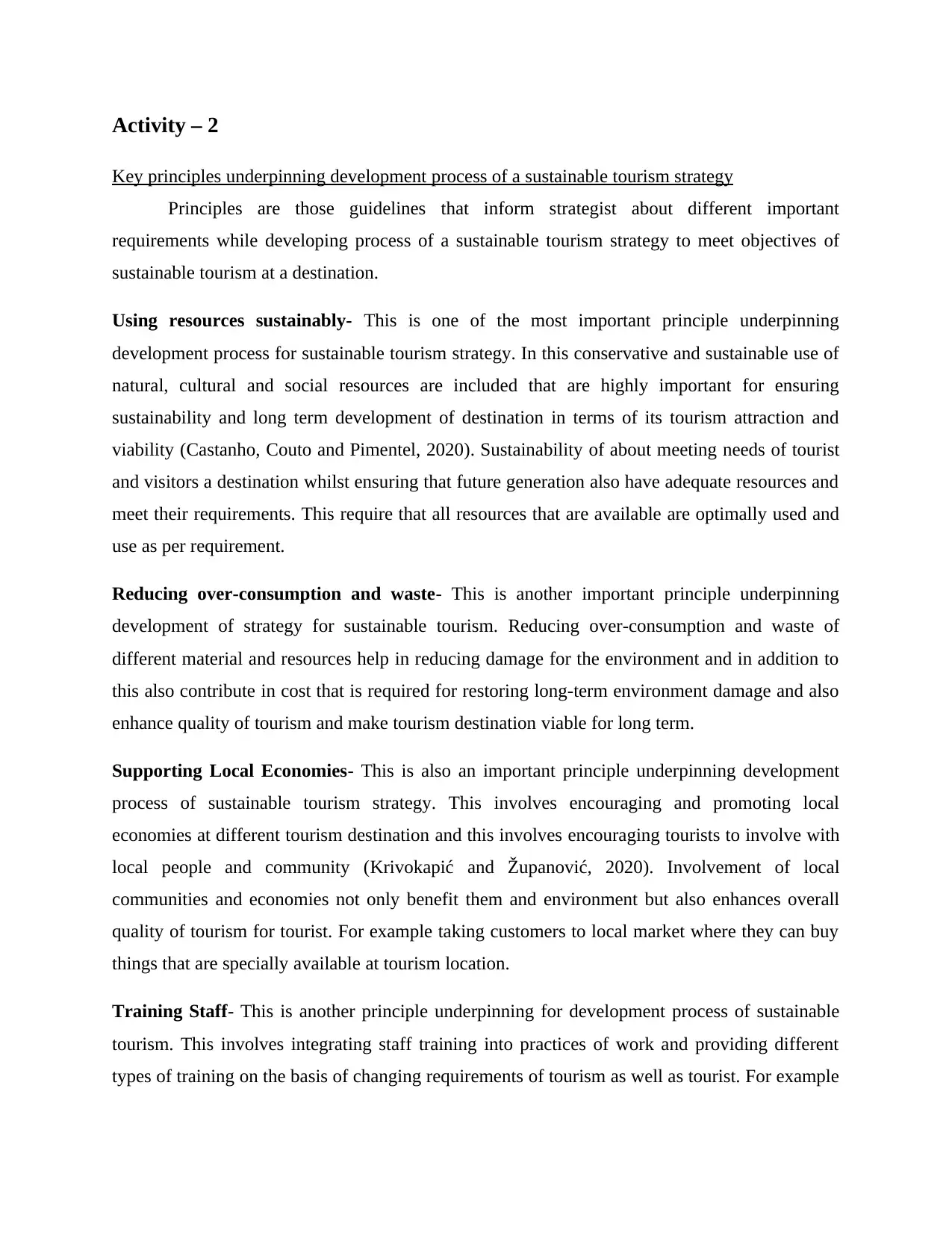
Activity – 2
Key principles underpinning development process of a sustainable tourism strategy
Principles are those guidelines that inform strategist about different important
requirements while developing process of a sustainable tourism strategy to meet objectives of
sustainable tourism at a destination.
Using resources sustainably- This is one of the most important principle underpinning
development process for sustainable tourism strategy. In this conservative and sustainable use of
natural, cultural and social resources are included that are highly important for ensuring
sustainability and long term development of destination in terms of its tourism attraction and
viability (Castanho, Couto and Pimentel, 2020). Sustainability of about meeting needs of tourist
and visitors a destination whilst ensuring that future generation also have adequate resources and
meet their requirements. This require that all resources that are available are optimally used and
use as per requirement.
Reducing over-consumption and waste- This is another important principle underpinning
development of strategy for sustainable tourism. Reducing over-consumption and waste of
different material and resources help in reducing damage for the environment and in addition to
this also contribute in cost that is required for restoring long-term environment damage and also
enhance quality of tourism and make tourism destination viable for long term.
Supporting Local Economies- This is also an important principle underpinning development
process of sustainable tourism strategy. This involves encouraging and promoting local
economies at different tourism destination and this involves encouraging tourists to involve with
local people and community (Krivokapić and Županović, 2020). Involvement of local
communities and economies not only benefit them and environment but also enhances overall
quality of tourism for tourist. For example taking customers to local market where they can buy
things that are specially available at tourism location.
Training Staff- This is another principle underpinning for development process of sustainable
tourism. This involves integrating staff training into practices of work and providing different
types of training on the basis of changing requirements of tourism as well as tourist. For example
Key principles underpinning development process of a sustainable tourism strategy
Principles are those guidelines that inform strategist about different important
requirements while developing process of a sustainable tourism strategy to meet objectives of
sustainable tourism at a destination.
Using resources sustainably- This is one of the most important principle underpinning
development process for sustainable tourism strategy. In this conservative and sustainable use of
natural, cultural and social resources are included that are highly important for ensuring
sustainability and long term development of destination in terms of its tourism attraction and
viability (Castanho, Couto and Pimentel, 2020). Sustainability of about meeting needs of tourist
and visitors a destination whilst ensuring that future generation also have adequate resources and
meet their requirements. This require that all resources that are available are optimally used and
use as per requirement.
Reducing over-consumption and waste- This is another important principle underpinning
development of strategy for sustainable tourism. Reducing over-consumption and waste of
different material and resources help in reducing damage for the environment and in addition to
this also contribute in cost that is required for restoring long-term environment damage and also
enhance quality of tourism and make tourism destination viable for long term.
Supporting Local Economies- This is also an important principle underpinning development
process of sustainable tourism strategy. This involves encouraging and promoting local
economies at different tourism destination and this involves encouraging tourists to involve with
local people and community (Krivokapić and Županović, 2020). Involvement of local
communities and economies not only benefit them and environment but also enhances overall
quality of tourism for tourist. For example taking customers to local market where they can buy
things that are specially available at tourism location.
Training Staff- This is another principle underpinning for development process of sustainable
tourism. This involves integrating staff training into practices of work and providing different
types of training on the basis of changing requirements of tourism as well as tourist. For example
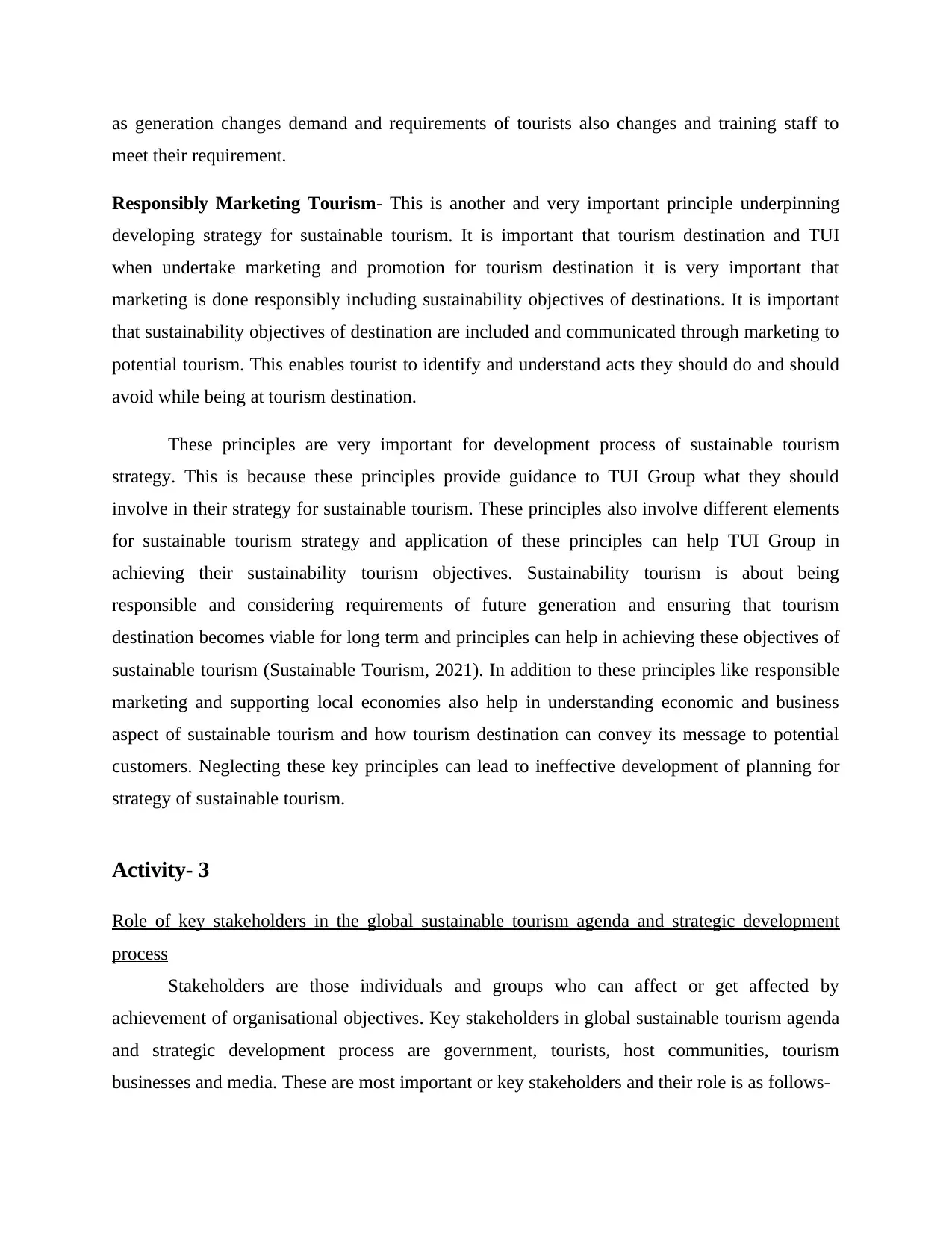
as generation changes demand and requirements of tourists also changes and training staff to
meet their requirement.
Responsibly Marketing Tourism- This is another and very important principle underpinning
developing strategy for sustainable tourism. It is important that tourism destination and TUI
when undertake marketing and promotion for tourism destination it is very important that
marketing is done responsibly including sustainability objectives of destinations. It is important
that sustainability objectives of destination are included and communicated through marketing to
potential tourism. This enables tourist to identify and understand acts they should do and should
avoid while being at tourism destination.
These principles are very important for development process of sustainable tourism
strategy. This is because these principles provide guidance to TUI Group what they should
involve in their strategy for sustainable tourism. These principles also involve different elements
for sustainable tourism strategy and application of these principles can help TUI Group in
achieving their sustainability tourism objectives. Sustainability tourism is about being
responsible and considering requirements of future generation and ensuring that tourism
destination becomes viable for long term and principles can help in achieving these objectives of
sustainable tourism (Sustainable Tourism, 2021). In addition to these principles like responsible
marketing and supporting local economies also help in understanding economic and business
aspect of sustainable tourism and how tourism destination can convey its message to potential
customers. Neglecting these key principles can lead to ineffective development of planning for
strategy of sustainable tourism.
Activity- 3
Role of key stakeholders in the global sustainable tourism agenda and strategic development
process
Stakeholders are those individuals and groups who can affect or get affected by
achievement of organisational objectives. Key stakeholders in global sustainable tourism agenda
and strategic development process are government, tourists, host communities, tourism
businesses and media. These are most important or key stakeholders and their role is as follows-
meet their requirement.
Responsibly Marketing Tourism- This is another and very important principle underpinning
developing strategy for sustainable tourism. It is important that tourism destination and TUI
when undertake marketing and promotion for tourism destination it is very important that
marketing is done responsibly including sustainability objectives of destinations. It is important
that sustainability objectives of destination are included and communicated through marketing to
potential tourism. This enables tourist to identify and understand acts they should do and should
avoid while being at tourism destination.
These principles are very important for development process of sustainable tourism
strategy. This is because these principles provide guidance to TUI Group what they should
involve in their strategy for sustainable tourism. These principles also involve different elements
for sustainable tourism strategy and application of these principles can help TUI Group in
achieving their sustainability tourism objectives. Sustainability tourism is about being
responsible and considering requirements of future generation and ensuring that tourism
destination becomes viable for long term and principles can help in achieving these objectives of
sustainable tourism (Sustainable Tourism, 2021). In addition to these principles like responsible
marketing and supporting local economies also help in understanding economic and business
aspect of sustainable tourism and how tourism destination can convey its message to potential
customers. Neglecting these key principles can lead to ineffective development of planning for
strategy of sustainable tourism.
Activity- 3
Role of key stakeholders in the global sustainable tourism agenda and strategic development
process
Stakeholders are those individuals and groups who can affect or get affected by
achievement of organisational objectives. Key stakeholders in global sustainable tourism agenda
and strategic development process are government, tourists, host communities, tourism
businesses and media. These are most important or key stakeholders and their role is as follows-
⊘ This is a preview!⊘
Do you want full access?
Subscribe today to unlock all pages.

Trusted by 1+ million students worldwide
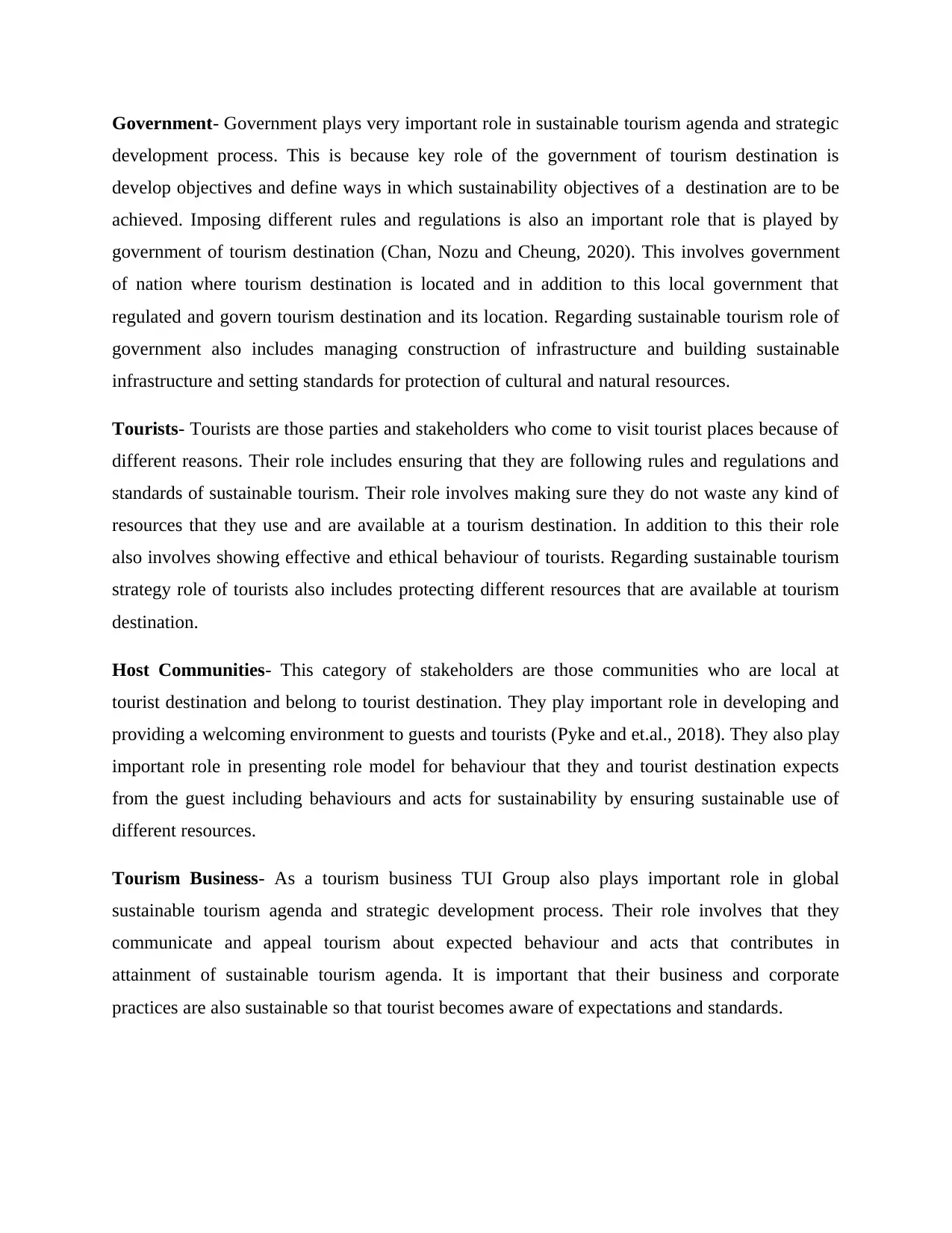
Government- Government plays very important role in sustainable tourism agenda and strategic
development process. This is because key role of the government of tourism destination is
develop objectives and define ways in which sustainability objectives of a destination are to be
achieved. Imposing different rules and regulations is also an important role that is played by
government of tourism destination (Chan, Nozu and Cheung, 2020). This involves government
of nation where tourism destination is located and in addition to this local government that
regulated and govern tourism destination and its location. Regarding sustainable tourism role of
government also includes managing construction of infrastructure and building sustainable
infrastructure and setting standards for protection of cultural and natural resources.
Tourists- Tourists are those parties and stakeholders who come to visit tourist places because of
different reasons. Their role includes ensuring that they are following rules and regulations and
standards of sustainable tourism. Their role involves making sure they do not waste any kind of
resources that they use and are available at a tourism destination. In addition to this their role
also involves showing effective and ethical behaviour of tourists. Regarding sustainable tourism
strategy role of tourists also includes protecting different resources that are available at tourism
destination.
Host Communities- This category of stakeholders are those communities who are local at
tourist destination and belong to tourist destination. They play important role in developing and
providing a welcoming environment to guests and tourists (Pyke and et.al., 2018). They also play
important role in presenting role model for behaviour that they and tourist destination expects
from the guest including behaviours and acts for sustainability by ensuring sustainable use of
different resources.
Tourism Business- As a tourism business TUI Group also plays important role in global
sustainable tourism agenda and strategic development process. Their role involves that they
communicate and appeal tourism about expected behaviour and acts that contributes in
attainment of sustainable tourism agenda. It is important that their business and corporate
practices are also sustainable so that tourist becomes aware of expectations and standards.
development process. This is because key role of the government of tourism destination is
develop objectives and define ways in which sustainability objectives of a destination are to be
achieved. Imposing different rules and regulations is also an important role that is played by
government of tourism destination (Chan, Nozu and Cheung, 2020). This involves government
of nation where tourism destination is located and in addition to this local government that
regulated and govern tourism destination and its location. Regarding sustainable tourism role of
government also includes managing construction of infrastructure and building sustainable
infrastructure and setting standards for protection of cultural and natural resources.
Tourists- Tourists are those parties and stakeholders who come to visit tourist places because of
different reasons. Their role includes ensuring that they are following rules and regulations and
standards of sustainable tourism. Their role involves making sure they do not waste any kind of
resources that they use and are available at a tourism destination. In addition to this their role
also involves showing effective and ethical behaviour of tourists. Regarding sustainable tourism
strategy role of tourists also includes protecting different resources that are available at tourism
destination.
Host Communities- This category of stakeholders are those communities who are local at
tourist destination and belong to tourist destination. They play important role in developing and
providing a welcoming environment to guests and tourists (Pyke and et.al., 2018). They also play
important role in presenting role model for behaviour that they and tourist destination expects
from the guest including behaviours and acts for sustainability by ensuring sustainable use of
different resources.
Tourism Business- As a tourism business TUI Group also plays important role in global
sustainable tourism agenda and strategic development process. Their role involves that they
communicate and appeal tourism about expected behaviour and acts that contributes in
attainment of sustainable tourism agenda. It is important that their business and corporate
practices are also sustainable so that tourist becomes aware of expectations and standards.
Paraphrase This Document
Need a fresh take? Get an instant paraphrase of this document with our AI Paraphraser
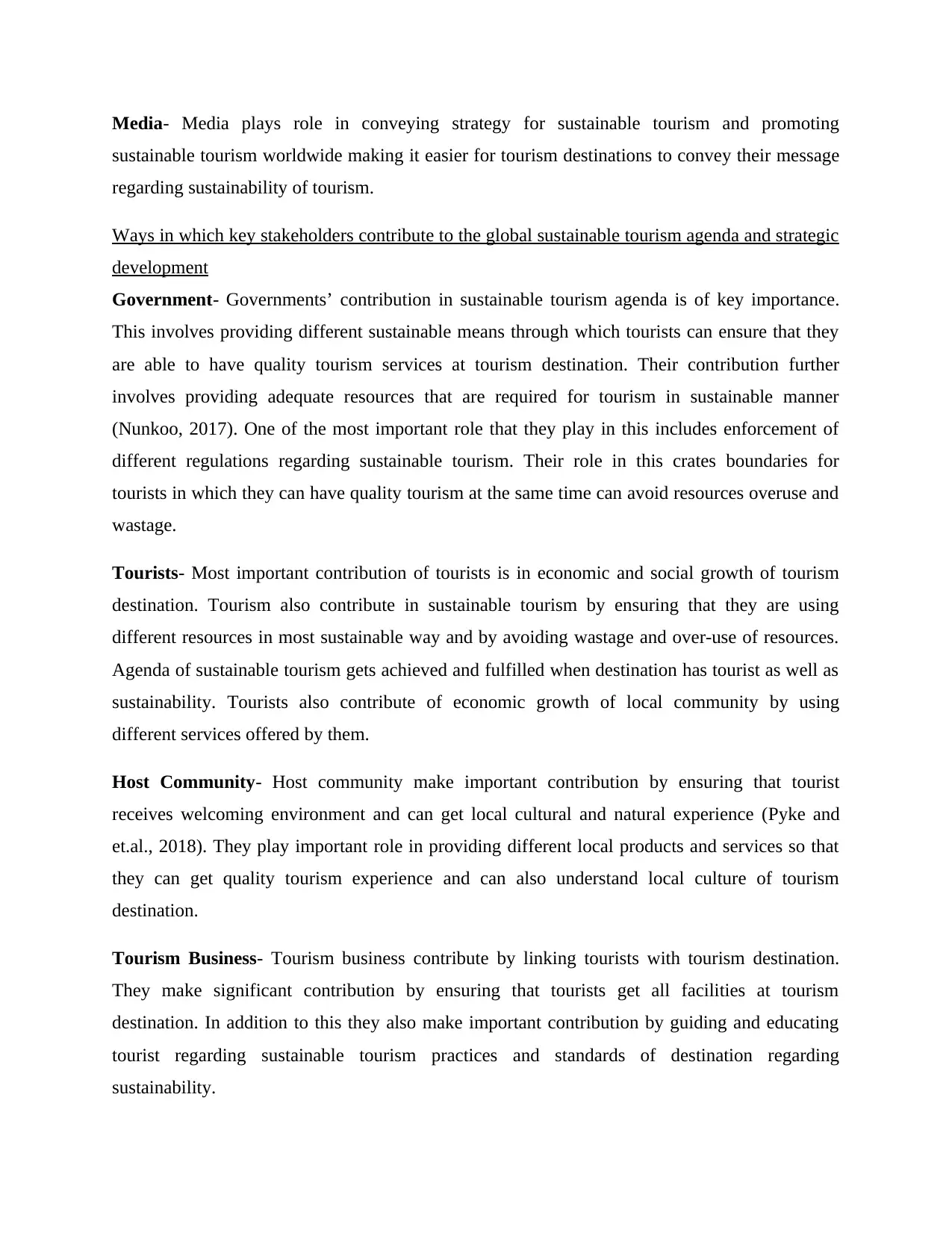
Media- Media plays role in conveying strategy for sustainable tourism and promoting
sustainable tourism worldwide making it easier for tourism destinations to convey their message
regarding sustainability of tourism.
Ways in which key stakeholders contribute to the global sustainable tourism agenda and strategic
development
Government- Governments’ contribution in sustainable tourism agenda is of key importance.
This involves providing different sustainable means through which tourists can ensure that they
are able to have quality tourism services at tourism destination. Their contribution further
involves providing adequate resources that are required for tourism in sustainable manner
(Nunkoo, 2017). One of the most important role that they play in this includes enforcement of
different regulations regarding sustainable tourism. Their role in this crates boundaries for
tourists in which they can have quality tourism at the same time can avoid resources overuse and
wastage.
Tourists- Most important contribution of tourists is in economic and social growth of tourism
destination. Tourism also contribute in sustainable tourism by ensuring that they are using
different resources in most sustainable way and by avoiding wastage and over-use of resources.
Agenda of sustainable tourism gets achieved and fulfilled when destination has tourist as well as
sustainability. Tourists also contribute of economic growth of local community by using
different services offered by them.
Host Community- Host community make important contribution by ensuring that tourist
receives welcoming environment and can get local cultural and natural experience (Pyke and
et.al., 2018). They play important role in providing different local products and services so that
they can get quality tourism experience and can also understand local culture of tourism
destination.
Tourism Business- Tourism business contribute by linking tourists with tourism destination.
They make significant contribution by ensuring that tourists get all facilities at tourism
destination. In addition to this they also make important contribution by guiding and educating
tourist regarding sustainable tourism practices and standards of destination regarding
sustainability.
sustainable tourism worldwide making it easier for tourism destinations to convey their message
regarding sustainability of tourism.
Ways in which key stakeholders contribute to the global sustainable tourism agenda and strategic
development
Government- Governments’ contribution in sustainable tourism agenda is of key importance.
This involves providing different sustainable means through which tourists can ensure that they
are able to have quality tourism services at tourism destination. Their contribution further
involves providing adequate resources that are required for tourism in sustainable manner
(Nunkoo, 2017). One of the most important role that they play in this includes enforcement of
different regulations regarding sustainable tourism. Their role in this crates boundaries for
tourists in which they can have quality tourism at the same time can avoid resources overuse and
wastage.
Tourists- Most important contribution of tourists is in economic and social growth of tourism
destination. Tourism also contribute in sustainable tourism by ensuring that they are using
different resources in most sustainable way and by avoiding wastage and over-use of resources.
Agenda of sustainable tourism gets achieved and fulfilled when destination has tourist as well as
sustainability. Tourists also contribute of economic growth of local community by using
different services offered by them.
Host Community- Host community make important contribution by ensuring that tourist
receives welcoming environment and can get local cultural and natural experience (Pyke and
et.al., 2018). They play important role in providing different local products and services so that
they can get quality tourism experience and can also understand local culture of tourism
destination.
Tourism Business- Tourism business contribute by linking tourists with tourism destination.
They make significant contribution by ensuring that tourists get all facilities at tourism
destination. In addition to this they also make important contribution by guiding and educating
tourist regarding sustainable tourism practices and standards of destination regarding
sustainability.
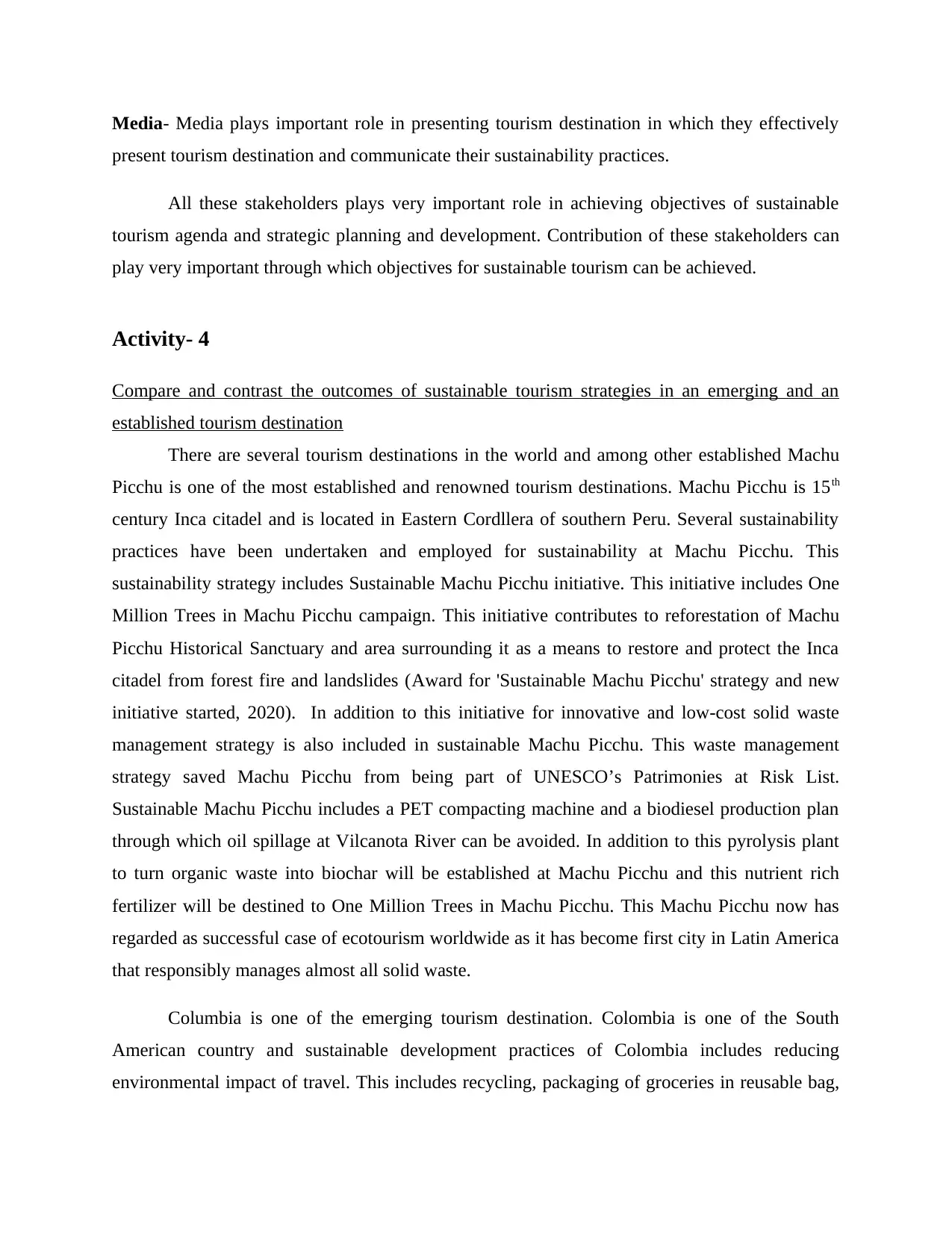
Media- Media plays important role in presenting tourism destination in which they effectively
present tourism destination and communicate their sustainability practices.
All these stakeholders plays very important role in achieving objectives of sustainable
tourism agenda and strategic planning and development. Contribution of these stakeholders can
play very important through which objectives for sustainable tourism can be achieved.
Activity- 4
Compare and contrast the outcomes of sustainable tourism strategies in an emerging and an
established tourism destination
There are several tourism destinations in the world and among other established Machu
Picchu is one of the most established and renowned tourism destinations. Machu Picchu is 15th
century Inca citadel and is located in Eastern Cordllera of southern Peru. Several sustainability
practices have been undertaken and employed for sustainability at Machu Picchu. This
sustainability strategy includes Sustainable Machu Picchu initiative. This initiative includes One
Million Trees in Machu Picchu campaign. This initiative contributes to reforestation of Machu
Picchu Historical Sanctuary and area surrounding it as a means to restore and protect the Inca
citadel from forest fire and landslides (Award for 'Sustainable Machu Picchu' strategy and new
initiative started, 2020). In addition to this initiative for innovative and low-cost solid waste
management strategy is also included in sustainable Machu Picchu. This waste management
strategy saved Machu Picchu from being part of UNESCO’s Patrimonies at Risk List.
Sustainable Machu Picchu includes a PET compacting machine and a biodiesel production plan
through which oil spillage at Vilcanota River can be avoided. In addition to this pyrolysis plant
to turn organic waste into biochar will be established at Machu Picchu and this nutrient rich
fertilizer will be destined to One Million Trees in Machu Picchu. This Machu Picchu now has
regarded as successful case of ecotourism worldwide as it has become first city in Latin America
that responsibly manages almost all solid waste.
Columbia is one of the emerging tourism destination. Colombia is one of the South
American country and sustainable development practices of Colombia includes reducing
environmental impact of travel. This includes recycling, packaging of groceries in reusable bag,
present tourism destination and communicate their sustainability practices.
All these stakeholders plays very important role in achieving objectives of sustainable
tourism agenda and strategic planning and development. Contribution of these stakeholders can
play very important through which objectives for sustainable tourism can be achieved.
Activity- 4
Compare and contrast the outcomes of sustainable tourism strategies in an emerging and an
established tourism destination
There are several tourism destinations in the world and among other established Machu
Picchu is one of the most established and renowned tourism destinations. Machu Picchu is 15th
century Inca citadel and is located in Eastern Cordllera of southern Peru. Several sustainability
practices have been undertaken and employed for sustainability at Machu Picchu. This
sustainability strategy includes Sustainable Machu Picchu initiative. This initiative includes One
Million Trees in Machu Picchu campaign. This initiative contributes to reforestation of Machu
Picchu Historical Sanctuary and area surrounding it as a means to restore and protect the Inca
citadel from forest fire and landslides (Award for 'Sustainable Machu Picchu' strategy and new
initiative started, 2020). In addition to this initiative for innovative and low-cost solid waste
management strategy is also included in sustainable Machu Picchu. This waste management
strategy saved Machu Picchu from being part of UNESCO’s Patrimonies at Risk List.
Sustainable Machu Picchu includes a PET compacting machine and a biodiesel production plan
through which oil spillage at Vilcanota River can be avoided. In addition to this pyrolysis plant
to turn organic waste into biochar will be established at Machu Picchu and this nutrient rich
fertilizer will be destined to One Million Trees in Machu Picchu. This Machu Picchu now has
regarded as successful case of ecotourism worldwide as it has become first city in Latin America
that responsibly manages almost all solid waste.
Columbia is one of the emerging tourism destination. Colombia is one of the South
American country and sustainable development practices of Colombia includes reducing
environmental impact of travel. This includes recycling, packaging of groceries in reusable bag,
⊘ This is a preview!⊘
Do you want full access?
Subscribe today to unlock all pages.

Trusted by 1+ million students worldwide
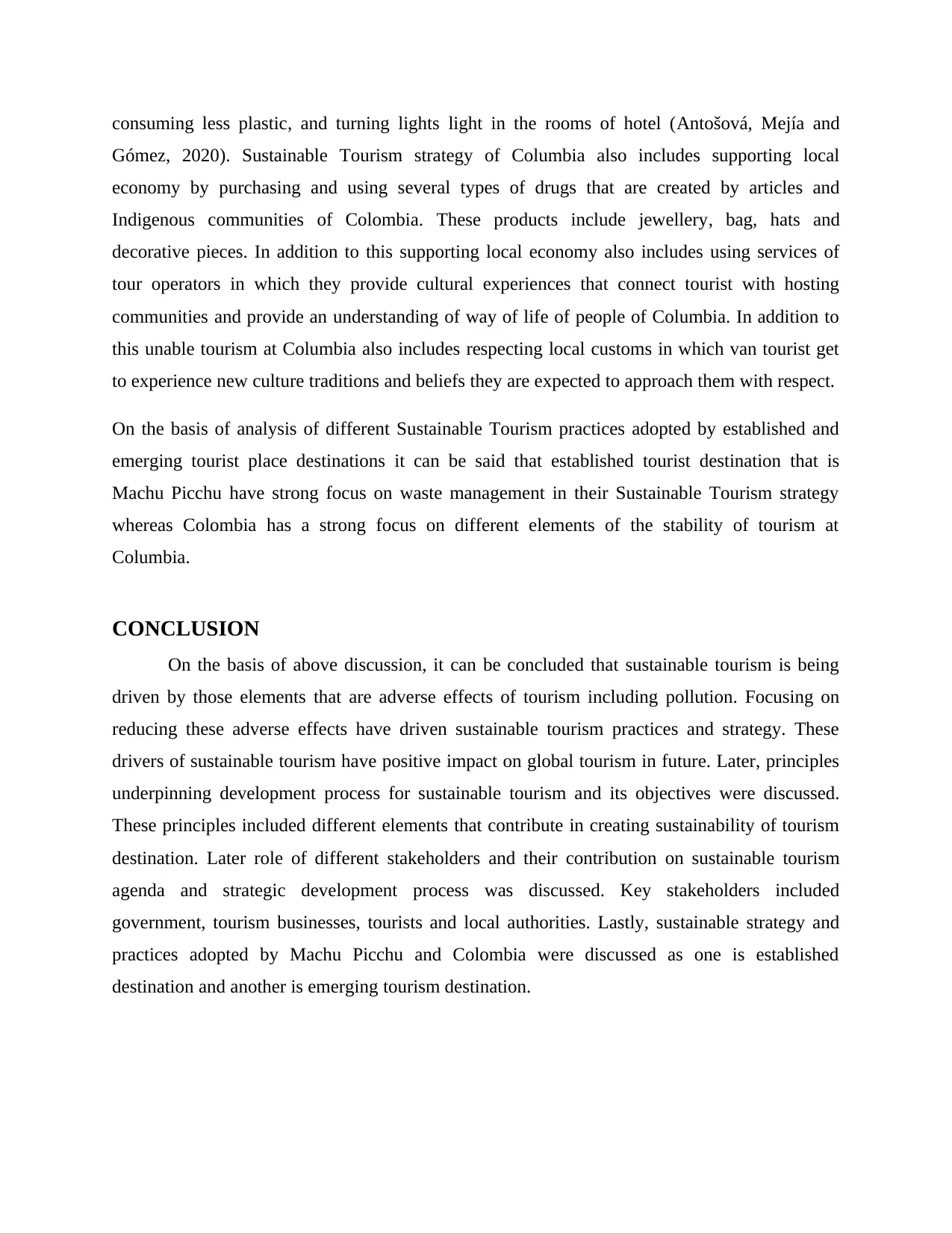
consuming less plastic, and turning lights light in the rooms of hotel (Antošová, Mejía and
Gómez, 2020). Sustainable Tourism strategy of Columbia also includes supporting local
economy by purchasing and using several types of drugs that are created by articles and
Indigenous communities of Colombia. These products include jewellery, bag, hats and
decorative pieces. In addition to this supporting local economy also includes using services of
tour operators in which they provide cultural experiences that connect tourist with hosting
communities and provide an understanding of way of life of people of Columbia. In addition to
this unable tourism at Columbia also includes respecting local customs in which van tourist get
to experience new culture traditions and beliefs they are expected to approach them with respect.
On the basis of analysis of different Sustainable Tourism practices adopted by established and
emerging tourist place destinations it can be said that established tourist destination that is
Machu Picchu have strong focus on waste management in their Sustainable Tourism strategy
whereas Colombia has a strong focus on different elements of the stability of tourism at
Columbia.
CONCLUSION
On the basis of above discussion, it can be concluded that sustainable tourism is being
driven by those elements that are adverse effects of tourism including pollution. Focusing on
reducing these adverse effects have driven sustainable tourism practices and strategy. These
drivers of sustainable tourism have positive impact on global tourism in future. Later, principles
underpinning development process for sustainable tourism and its objectives were discussed.
These principles included different elements that contribute in creating sustainability of tourism
destination. Later role of different stakeholders and their contribution on sustainable tourism
agenda and strategic development process was discussed. Key stakeholders included
government, tourism businesses, tourists and local authorities. Lastly, sustainable strategy and
practices adopted by Machu Picchu and Colombia were discussed as one is established
destination and another is emerging tourism destination.
Gómez, 2020). Sustainable Tourism strategy of Columbia also includes supporting local
economy by purchasing and using several types of drugs that are created by articles and
Indigenous communities of Colombia. These products include jewellery, bag, hats and
decorative pieces. In addition to this supporting local economy also includes using services of
tour operators in which they provide cultural experiences that connect tourist with hosting
communities and provide an understanding of way of life of people of Columbia. In addition to
this unable tourism at Columbia also includes respecting local customs in which van tourist get
to experience new culture traditions and beliefs they are expected to approach them with respect.
On the basis of analysis of different Sustainable Tourism practices adopted by established and
emerging tourist place destinations it can be said that established tourist destination that is
Machu Picchu have strong focus on waste management in their Sustainable Tourism strategy
whereas Colombia has a strong focus on different elements of the stability of tourism at
Columbia.
CONCLUSION
On the basis of above discussion, it can be concluded that sustainable tourism is being
driven by those elements that are adverse effects of tourism including pollution. Focusing on
reducing these adverse effects have driven sustainable tourism practices and strategy. These
drivers of sustainable tourism have positive impact on global tourism in future. Later, principles
underpinning development process for sustainable tourism and its objectives were discussed.
These principles included different elements that contribute in creating sustainability of tourism
destination. Later role of different stakeholders and their contribution on sustainable tourism
agenda and strategic development process was discussed. Key stakeholders included
government, tourism businesses, tourists and local authorities. Lastly, sustainable strategy and
practices adopted by Machu Picchu and Colombia were discussed as one is established
destination and another is emerging tourism destination.
Paraphrase This Document
Need a fresh take? Get an instant paraphrase of this document with our AI Paraphraser
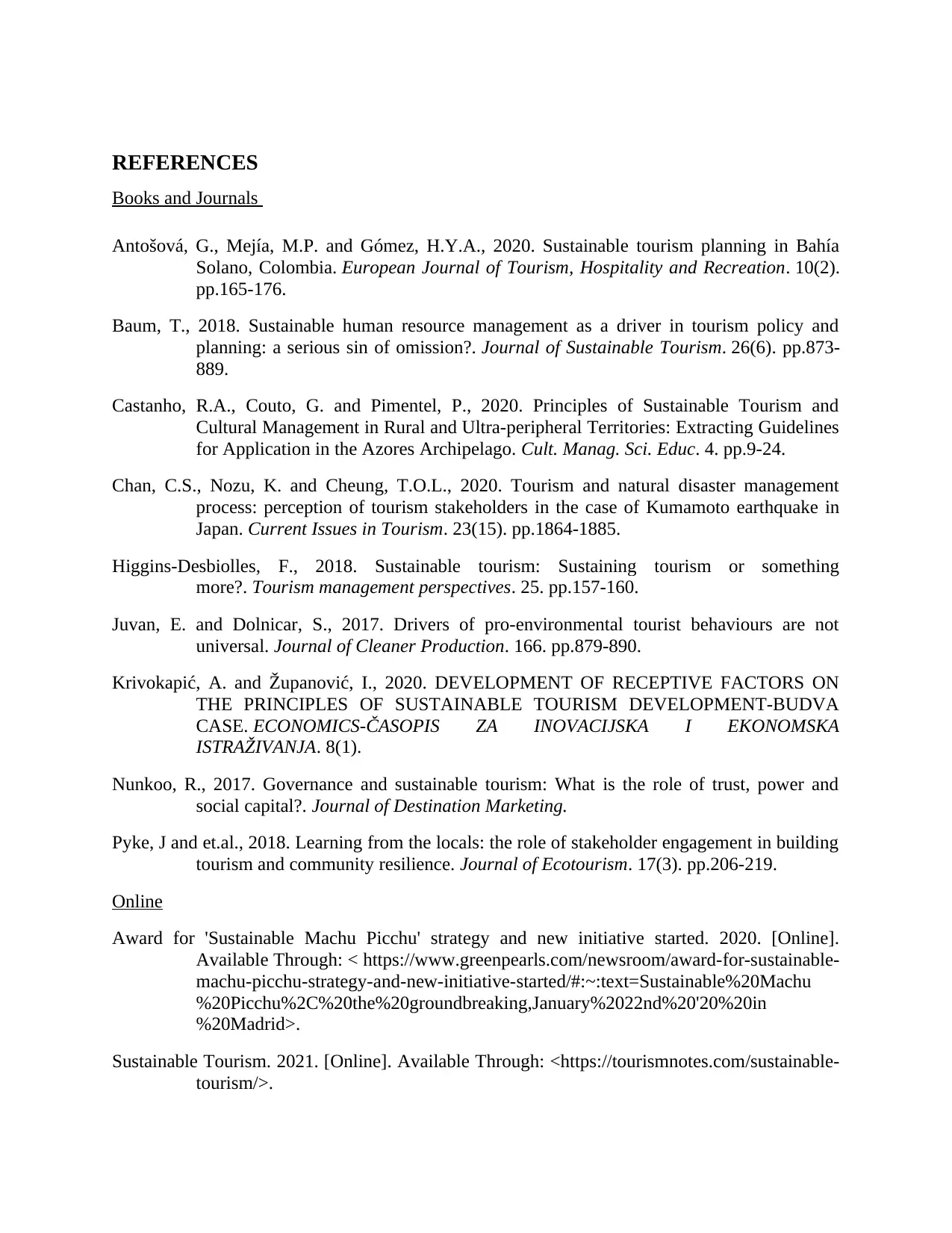
REFERENCES
Books and Journals
Antošová, G., Mejía, M.P. and Gómez, H.Y.A., 2020. Sustainable tourism planning in Bahía
Solano, Colombia. European Journal of Tourism, Hospitality and Recreation. 10(2).
pp.165-176.
Baum, T., 2018. Sustainable human resource management as a driver in tourism policy and
planning: a serious sin of omission?. Journal of Sustainable Tourism. 26(6). pp.873-
889.
Castanho, R.A., Couto, G. and Pimentel, P., 2020. Principles of Sustainable Tourism and
Cultural Management in Rural and Ultra-peripheral Territories: Extracting Guidelines
for Application in the Azores Archipelago. Cult. Manag. Sci. Educ. 4. pp.9-24.
Chan, C.S., Nozu, K. and Cheung, T.O.L., 2020. Tourism and natural disaster management
process: perception of tourism stakeholders in the case of Kumamoto earthquake in
Japan. Current Issues in Tourism. 23(15). pp.1864-1885.
Higgins-Desbiolles, F., 2018. Sustainable tourism: Sustaining tourism or something
more?. Tourism management perspectives. 25. pp.157-160.
Juvan, E. and Dolnicar, S., 2017. Drivers of pro-environmental tourist behaviours are not
universal. Journal of Cleaner Production. 166. pp.879-890.
Krivokapić, A. and Županović, I., 2020. DEVELOPMENT OF RECEPTIVE FACTORS ON
THE PRINCIPLES OF SUSTAINABLE TOURISM DEVELOPMENT-BUDVA
CASE. ECONOMICS-ČASOPIS ZA INOVACIJSKA I EKONOMSKA
ISTRAŽIVANJA. 8(1).
Nunkoo, R., 2017. Governance and sustainable tourism: What is the role of trust, power and
social capital?. Journal of Destination Marketing.
Pyke, J and et.al., 2018. Learning from the locals: the role of stakeholder engagement in building
tourism and community resilience. Journal of Ecotourism. 17(3). pp.206-219.
Online
Award for 'Sustainable Machu Picchu' strategy and new initiative started. 2020. [Online].
Available Through: < https://www.greenpearls.com/newsroom/award-for-sustainable-
machu-picchu-strategy-and-new-initiative-started/#:~:text=Sustainable%20Machu
%20Picchu%2C%20the%20groundbreaking,January%2022nd%20'20%20in
%20Madrid>.
Sustainable Tourism. 2021. [Online]. Available Through: <https://tourismnotes.com/sustainable-
tourism/>.
Books and Journals
Antošová, G., Mejía, M.P. and Gómez, H.Y.A., 2020. Sustainable tourism planning in Bahía
Solano, Colombia. European Journal of Tourism, Hospitality and Recreation. 10(2).
pp.165-176.
Baum, T., 2018. Sustainable human resource management as a driver in tourism policy and
planning: a serious sin of omission?. Journal of Sustainable Tourism. 26(6). pp.873-
889.
Castanho, R.A., Couto, G. and Pimentel, P., 2020. Principles of Sustainable Tourism and
Cultural Management in Rural and Ultra-peripheral Territories: Extracting Guidelines
for Application in the Azores Archipelago. Cult. Manag. Sci. Educ. 4. pp.9-24.
Chan, C.S., Nozu, K. and Cheung, T.O.L., 2020. Tourism and natural disaster management
process: perception of tourism stakeholders in the case of Kumamoto earthquake in
Japan. Current Issues in Tourism. 23(15). pp.1864-1885.
Higgins-Desbiolles, F., 2018. Sustainable tourism: Sustaining tourism or something
more?. Tourism management perspectives. 25. pp.157-160.
Juvan, E. and Dolnicar, S., 2017. Drivers of pro-environmental tourist behaviours are not
universal. Journal of Cleaner Production. 166. pp.879-890.
Krivokapić, A. and Županović, I., 2020. DEVELOPMENT OF RECEPTIVE FACTORS ON
THE PRINCIPLES OF SUSTAINABLE TOURISM DEVELOPMENT-BUDVA
CASE. ECONOMICS-ČASOPIS ZA INOVACIJSKA I EKONOMSKA
ISTRAŽIVANJA. 8(1).
Nunkoo, R., 2017. Governance and sustainable tourism: What is the role of trust, power and
social capital?. Journal of Destination Marketing.
Pyke, J and et.al., 2018. Learning from the locals: the role of stakeholder engagement in building
tourism and community resilience. Journal of Ecotourism. 17(3). pp.206-219.
Online
Award for 'Sustainable Machu Picchu' strategy and new initiative started. 2020. [Online].
Available Through: < https://www.greenpearls.com/newsroom/award-for-sustainable-
machu-picchu-strategy-and-new-initiative-started/#:~:text=Sustainable%20Machu
%20Picchu%2C%20the%20groundbreaking,January%2022nd%20'20%20in
%20Madrid>.
Sustainable Tourism. 2021. [Online]. Available Through: <https://tourismnotes.com/sustainable-
tourism/>.

The history of sustainable tourism. 2018. [Online]. Available Through:
<https://www.lookoutpro.com/en/the-history-of-sustainable-tourism/>.
<https://www.lookoutpro.com/en/the-history-of-sustainable-tourism/>.
⊘ This is a preview!⊘
Do you want full access?
Subscribe today to unlock all pages.

Trusted by 1+ million students worldwide
1 out of 12
Related Documents
Your All-in-One AI-Powered Toolkit for Academic Success.
+13062052269
info@desklib.com
Available 24*7 on WhatsApp / Email
![[object Object]](/_next/static/media/star-bottom.7253800d.svg)
Unlock your academic potential
Copyright © 2020–2025 A2Z Services. All Rights Reserved. Developed and managed by ZUCOL.





